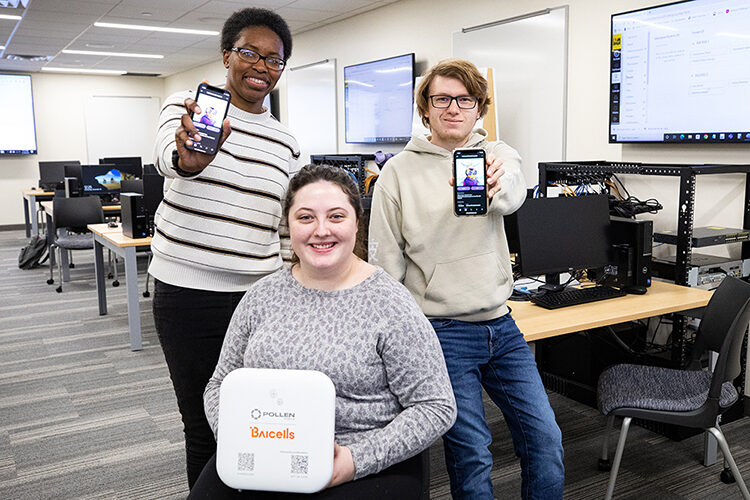Information studies students help build new wireless network to learn about blockchain
UWM School of Information Studies students Kailoni Montgomery (from left), Morgan Hays and Gabriel Josko learn about applications for blockchain technology by helping a new wireless company establish its coverage map using a mobile service that uses blockchain. (UWM Photo/Troye Fox)
When Kailoni Montgomery enrolled in Matt Friedel’s survey class on digital technologies, she had only a vague idea of what blockchain was.
“I just associated blockchain with cryptocurrency,” said Montgomery, an information studies undergraduate. “And I knew nothing about wide area wireless networks.”
Now she sees new possibilities for blockchain in addition to digital money exchange, she said, including an idea of her own.
Blockchain is a shared permanent ledger that allows users to process transactions and track assets in a business network. It stores the data securely and each of the continuous list of records has a time stamp.
Montgomery and two of her classmates provide hands-on assistance to a new wireless company that is building a nationwide network from scratch.
“The goal here is to show students how the company is using blockchain to bring down the cost of mobile services,” Friedel said. “I wanted to teach my class that there are other practical applications for blockchain – even if the cryptocurrency industry is lagging.”
A new model
Hexagon Wireless provided each of the participating students with a radio device that acts as a cell phone tower for a local area, such as a neighborhood. Once installed, the device, about the size of a toaster, emits radio signals needed to connect to the wireless network.
As students go about their daily routines armed with cell phones, they validate whether they are able to pick up the radio signals from their devices. This is a necessary step for the company in building its wireless coverage map, using a blockchain platform, said Russ From, Hexagon’s vice president of distribution.
As part of the work, the company is using students across the country to help them verify and expand the coverage map. Montgomery signed up, along with graduate students Morgan Hays and Gabriel Josko.
FTC opens up the market
Hexagon is the distribution partner of mobile service provider Pollen Mobile, which is planning its commercial launch around the first of the year.
Hexagon and Pollen Mobile got the chance to join the market in 2020, after the FCC increased the available radio frequencies on the wireless spectrum, making room for new operators. A blockchain platform will give them a financial advantage in a highly competitive market, From said.
One difference between Hexagon and telecommunications giants is the efficiency and speed that comes from a blockchain platform, he said. “We can deploy cell phones much faster because of that,” he said. “We can do two sites a day as opposed to it taking months. That means we’re doing it at a fraction of the cost.”
NFT plays a role
Working with Hexagon also gives the three students experience using another new staple of digital life: non-fungible tokens, or NFTs.
Mostly associated with internet art and collectibles, NFTs, like blockchain technologies, have other potential uses, Friedel said. NFTs can be both a digital asset and a certificate that authenticates ownership of a unique digital product that can also be linked to a physical item such as a radio device.
The affiliated NFT can give its owners royalties for certain activities, such as verification of mobile phone coverage, he said.
Each of the units Hexagon has provided to the students has an NFT connected to it. Their individual NFTs give students access to Hexagon’s wireless service for free, but also to their own digital wallets. Each time their cell phones pick up the device’s signal, students are rewarded with a small amount of cryptocurrency.
“I wanted to get involved to get a better understanding of how blockchain and NFTs work in the real world,” Josko said. “It’s also a way to understand cryptocurrency, and if I could make a few bucks along the way, all the better.”
Interested in ethical issues
Hays, a library and information science graduate student, wants to learn by actually using the technology, but she’s also curious about the bigger picture. “I’m interested in the ethical issues of new technology, including the gray areas,” Hays said. “So this project gives me some insight into that. Also, I wanted more exposure to technologies I might encounter in the job market.”
Montgomery said she was most drawn to the potential of using the new technology for the public good. Now, with the help of the Lubar Entrepreneurship Center, she is working on a concept that will give people in need an alternative to panhandling.
“My hope is to create a system that will make homeless people more likely to have enough money for food, necessities and resources for job hunting.”



